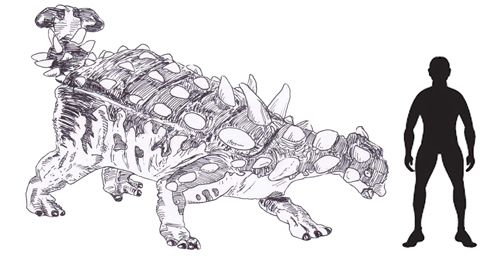Euoplocephalus tutus – “Well Armoured Head”
The first fossils ascribed to this armoured dinosaur were discovered in 1897 by an expedition mapping the Red Deer River area in Alberta (Canada), led by the famous Canadian palaeontologist Lawrence Lambe. This locality now forms part of the famous Dinosaur Provincial Park Formation of southern Alberta. It was Lambe who named this dinosaur Stereocephalus tutus in 1902, on the basis of a partial skull and five pieces of dermal armour, however the genus name had already been given to a type of beetle from South America that had been named in 1884, so a new genus name was erected in 1910.
Euoplocephalus tutus
Everything Dinosaur’s Scale Drawing of Euoplocephalus tutus
Picture credit: Everything Dinosaur
For models and replicas of armoured dinosaurs and other prehistoric animals: Safari Ltd. Wild Safari Prehistoric World Models.
Significant ankylosaurid specimens are relatively much rarer in the Dinosaur Provincial Park Formation when compared to other Ornithischian dinosaurs. Given the robust nature of the bones of these large animals and the amount of tough, dermal armour, this suggests that in the absence of a fossilisation bias, that Ankylosaurs may have inhabited areas that limited the potential for any remains to become fossils, or that these armoured dinosaurs made up only a small proportion of the total dinosaur population at any one time.
Euoplocephalus tutus, is, we at Everything Dinosaur think, the only ankylosaurid known from this formation. A study undertaken in 2003 provided a detailed analysis of Euoplocephalus cranial anatomy providing further evidence that this genus was indeed, distinct from Ankylosaurus. Early research examining the post cranial skeleton of Euoplocephalus identified subtle differences in the shape and size of the bony tail club. Euoplocephalus tail clubs could be grouped into three general categories:
- Rounded tail clubs
- Bluntly pointed at the end of the club
- Elongate tail clubs
Ankylosaur Tail Clubs
The scientist responsible for this study (Coombs 1995) suggested that this individual variation might be accounted for by the fact that as these dinosaurs grew so their tail clubs altered shape. Or it might be to do with allometric factors. When an animal changes shape in response to size changes, it is said to scale allometrically. In a discussion regarding tail club function in the same scientific paper, it was proposed that the tail club would have made a very effective defensive weapon against tyrannosaurids. If the tail club was swung and made contact with an attacking theropod’s ankle joint then it was likely to have broken bones and caused an immense amount of damage.
Last year, Everything Dinosaur wrote a short article on the talented Victoria Arbour, a leading specialist in the study of Ankylosaurs and armoured dinosaurs in general. Thanks to Victoria many young women are looking to palaeontology and other related sciences for a career.
To read more about Victoria’s contribution to our understanding of armoured dinosaurs: Helping to Inspire Young People to Study Earth Sciences







Leave A Comment